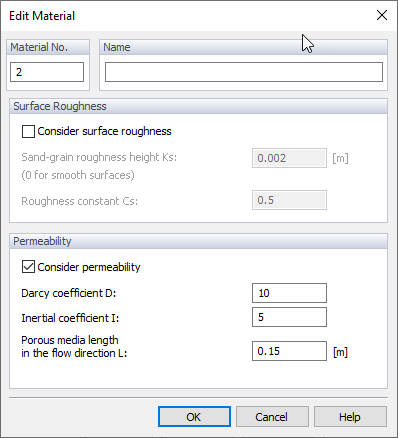在 RWIND 3 Pro 中可以对面应用渗透性。 关于渗透性的简要理论介绍,请参见章节 渗透性。 在 RWIND 3 Pro 中对渗透性进行建模使用边界条件,在定义的面上指定压降。 压降(压力梯度)由下式计算得出:
|
Δp[Pa] |
Pressure drop |
|
μ[Pa.s] |
Dynamic viscosity of the fluid |
|
U[m/s] |
Velocity of the fluid |
|
D[1/m2] |
Darcy coefficient |
|
I[1/m] |
Inertial coefficient |
|
ρ[kg/m3] |
Density of the fluid |
|
L[m] |
Permeable media length in the flow direction |
式中,系数 D 和 I 定义为:
在章节 渗透性 中讨论的可渗透介质模型中,在 N‑S 方程右侧要求解渗透性的单元格重心处添加了一个源项。 因为 RWIND 3 Pro 只求解可渗透的面(即相对薄的单元),所以到目前为止使用循环的边界条件 (porousBafflePressure) 对渗透性进行建模,规定所选单元(面)上的压力梯度。 有关更多详细信息,请参见 OpenFOAM 手册。 这是一个计算简单的模型,但是可以在很短的计算时间内得出有趣的结果。 然而,它也有其局限性,例如,对高压力降使用模型可能不会导致收敛和结果。
有关渗透性模型(porousBafflePressure)的更多具体信息,可在OpenFOAM-4.1手册中找到。
渗透性和分区
在 RWIND 3 Pro 中,渗透性作为材料属性分配给选定的区域,见下面的图像。
在“编辑区域”对话框的“材料”部分中,点击“创建新材料...”或“编辑材料...”。 出现一个对话框,该对话框包含 渗透性参数 。
在这里定义渗透系数 D、I 和渗透面的长度(厚度)L。 有关如何推导和获取这些系数的介绍已在第 渗透性 章中描述。 更多关于推导系数的想法和方法可以在这里找到:
Darcy-Forchheimer 计算器
在德儒巴网站的专题报告中介绍了一种获取渗透性系数和进行渗透性建模的方法。
在设置了所有系数并为面分配了分区后,面模型就可以用于计算了。



